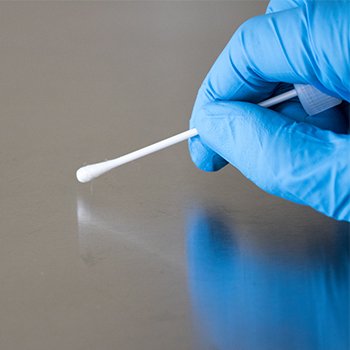สร้างความมั่นใจในประสิทธิภาพการทำความสะอาด ด้วยเทคนิคการตรวจสอบพื้นผิวสัมผัสอาหาร Cleaning Verification with Food Contact Surface Testing Techniques
1572 Views |

By: ภณิดา พิสัยสวัสดิ์
Panida Pisaisawat
Regional Technical Support Manager
Hygiena International Limited
ppisaisawat@hygiena.com
การเก็บตัวอย่างบนพื้นผิวโดยตรง (Direct method) การเก็บตัวอย่างบนพื้นผิวด้วยวิธีการสวอปแบบปลอดเชื้อเป็นวิธีการเก็บตัวอย่างในบริเวณที่เข้าถึงง่าย เช่น สายพาน อุปกรณ์ เครื่องจักร และมือพนักงาน เป็นต้น กรณีที่พื้นผิวเปียกสามารถใช้อุปกรณ์สวอปที่แห้งป้ายลงบนพื้นผิวได้โดยตรง ขณะที่พื้นผิวที่มีความแห้งควรทำให้อุปกรณ์สวอปมีความชุ่มชื้นด้วยบัฟเฟอร์ปลอดเชื้อก่อนที่จะนำไปสวอป หากเลือกใช้บัฟเฟอร์ที่มีความเหมาะสมกับชนิดของสารเคมีที่มีโอกาสตกค้างบนพื้นผิวก็จะทำให้ตัวอย่างที่สวอปนั้นมีความเป็นกลางและช่วยเพิ่มโอกาสในการตรวจพบเชื้อจุลินทรีย์ได้ดียิ่งขึ้น โดยบัฟเฟอร์ที่นิยมใช้ ได้แก่ Neutralizing Buffer, Buffered Peptone Water, Letheen Broth, D/E Neutralizing Buffer เป็นต้น
วิธีการเก็บตัวอย่างทำได้โดยการป้ายสวอปให้ทั่วบนพื้นผิวที่กำหนด เช่น 5×5 หรือ 10×10 ตารางเซนติเมตรสำหรับการตรวจหา ATP โปรตีน หรือเชื้อที่บ่งชี้ถึงประสิทธิภาพการทำความสะอาด และ 1 ฟุต×1 ฟุต สำหรับตรวจหาเชื้อจุลินทรีย์ก่อโรค ตัวอย่างที่ได้จากการสวอปพื้นผิวนี้สามารถนำไปวิเคราะห์ต่อได้อีกหลายเทคนิค เช่น
· เทคนิค ATP bioluminescence เป็นเทคนิคที่นิยมนำมาใช้ในการตรวจสอบประสิทธิภาพการทำความสะอาด เนื่องจากให้ผลลัพธ์ที่รวดเร็วภายใน 10-15 วินาที
· เทคนิคการตรวจหาโปรตีนตกค้าง เป็นการตรวจหาโปรตีนตกค้างบนพื้นผิวด้วยปฏิกิริยาไบยูเร็ต หลักการ คือ พื้นผิวที่ผ่านการทำความสะอาดอย่างมีประสิทธิภาพนั้น ไม่ควรจะมีโปรตีนทุกชนิดหลงเหลืออยู่ โดยหลังจากการสวอปและทำปฏิกิริยาแล้ว หากเกิดสีม่วงแสดงว่ามีโปรตีนตกค้างอยู่บนพื้นผิว
· เทคนิคการตรวจเชื้อ เป็นการตรวจสอบประสิทธิภาพน้ำยาฆ่าเชื้อด้วยการนำตัวอย่างที่สวอปแล้วไปทำการตรวจเชื้อจุลินทรีย์ที่บ่งชี้ถึงประสิทธิภาพในการทำความสะอาด
Direct method
The aseptic swab is a surface sampling technique for accessible areas such as worker hands, machinery, equipment, and conveyors. For wet surfaces, you can directly wipe over the surface with a dry swab. As for dry surfaces, the swab needs to be dampened with a sterile buffer before wiping. Selecting the correct buffer is crucial since it can neutralize the swab sample and improve microbial detection, providing the buffer is suitable for chemical residues on the surface. The most common buffers are neutralizing buffer, buffered peptone water, Letheen broth, and D/E neutralizing buffer.
Sampling can be done by wiping the swab evenly on a designated surface, for example, an area of 5×5 or 10×10 cm2 for detection of ATP, proteins, or microorganisms used as cleaning efficiency indicators, or an area of 1×1 ft2 for identification of pathogens. Swab samples can be further analyzed using many techniques, including;
· ATP bioluminescence assay: This widely used method of cleaning verification can provide results in 10 to 15 seconds.
· Residual protein assay: This method uses a biuret reaction to identify surface protein residues based on the idea that there should not be any protein residues on the surface following thorough cleaning. During the test reaction, if the sample turns purple, results indicate that protein residue is on the surface, meaning recleaning needs to be done.
· Microbial detection: It is a technique used in disinfectant efficacy verification. It involves detecting microorganisms in swab samples used as cleaning efficiency indicators.




